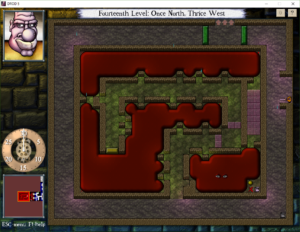JtRH: Enter the Mud
Level 14 of Journey to Rooted Hold is the first appearance of the Awakened Mud, which is sort of like inverse Living Tar. Where tar can be cut on its edges but not on its corners, mud can be cut on its corners but not on its edges. The result is that clearing mud is fundamentally simpler. Cutting away a corner generally creates a new corner adjacent to the old one, so in the absence of walls or other obstacles, you can clear any mudshape by shaving it away in layers. Thus, to avoid being trivial, mud puzzles tend to use walls or other obstacles.
When there’s something you need to reach in the middle of a large pool of tar — usually a Tar Mother — all you need to do is reach the pool’s edge and you can slice your way through the thick of it and straight to your objective. You can’t do that with mud. The only way get to the middle of a mud pool is by removing enough mud that it isn’t the middle any more. Relatedly, if tar growth leaves you completely surrounded, you can cut your way free, but in mud, you just get stuck, immobilized by stuff you can’t damage. In short, mud behaves very differently from tar, and has a very different effect on puzzles.
 JtRH takes a clever approach to illustrating this. Level 14 is basically just a selection of tar puzzles from King Dugan’s Dungeon turned upside-down and with the tar changed to mud. I don’t remember this from the first time I played through JtRH. Maybe I noticed at the time and just forgot about it, or maybe I’m only noticing this time around because I played KDD so recently. Regardless, the impact of recognition here is the one good reason I’ve seen for playing KDD before JtRH. It must be very strange to see the mud versions of these rooms first, because the conversion leaves in elements that don’t make sense, design-wise. For example, there’s one room that, in its original form, has a door that’s opened by an orb that’s very difficult to reach, because it’s in a tar-filled area that’s only exposed at its corners. In the mud version, the orb is trivial to reach, but also kind of pointless, because both sides of the door are also trivial to reach.
JtRH takes a clever approach to illustrating this. Level 14 is basically just a selection of tar puzzles from King Dugan’s Dungeon turned upside-down and with the tar changed to mud. I don’t remember this from the first time I played through JtRH. Maybe I noticed at the time and just forgot about it, or maybe I’m only noticing this time around because I played KDD so recently. Regardless, the impact of recognition here is the one good reason I’ve seen for playing KDD before JtRH. It must be very strange to see the mud versions of these rooms first, because the conversion leaves in elements that don’t make sense, design-wise. For example, there’s one room that, in its original form, has a door that’s opened by an orb that’s very difficult to reach, because it’s in a tar-filled area that’s only exposed at its corners. In the mud version, the orb is trivial to reach, but also kind of pointless, because both sides of the door are also trivial to reach.
What really tickles me is the way the game builds story around all this. Overheard conversations and discarded memos depict a feud between the Tar Technicians and the Mud Coordinators, the latter being a recently-formed group that’s regarded by the former as upstarts peddling an inferior imitation. And the Tar Technicians have a point. Mud is inferior to tar from pretty much every perspective. As a defense, it’s more easily defeated. Because it’s so easily cleared, it has less potential for interesting puzzle design. Because you have to peel it away in layers instead of just plowing through the middle, it’s more tedious for the player. The reuse of old tar puzzles doesn’t just illustrate the differences between the two substances, it reinforces the “inferior imitation” idea, as if the Mud Coordinators didn’t have any new ideas of their own. From one overheard conversation, we learn that the reason that the rooms of Level 14 are all upside-down from the originals is that the architect was holding the blueprint the wrong way up, further emphasizing the sense of incompetence.
This is stuff we didn’t see in KDD. When tar was first introduced, it was just a new puzzle element, one of those things you find in dungeons. In JtRH, new elements have stories associated with them, with characters and conflicts and meaning. And old elements gain these things retroactively.
 Comments(1)
Comments(1)
As I remember, this was inspired by the internal discussions we had around introducing mud. I hated it, thought it was a waste of dev time, and went so far as to build no doubt terrible puzzles to demonstrate how limited this new element was. This backfired, but it inspired mud’s backstory as an alternative, inferior, unaccountable offering.